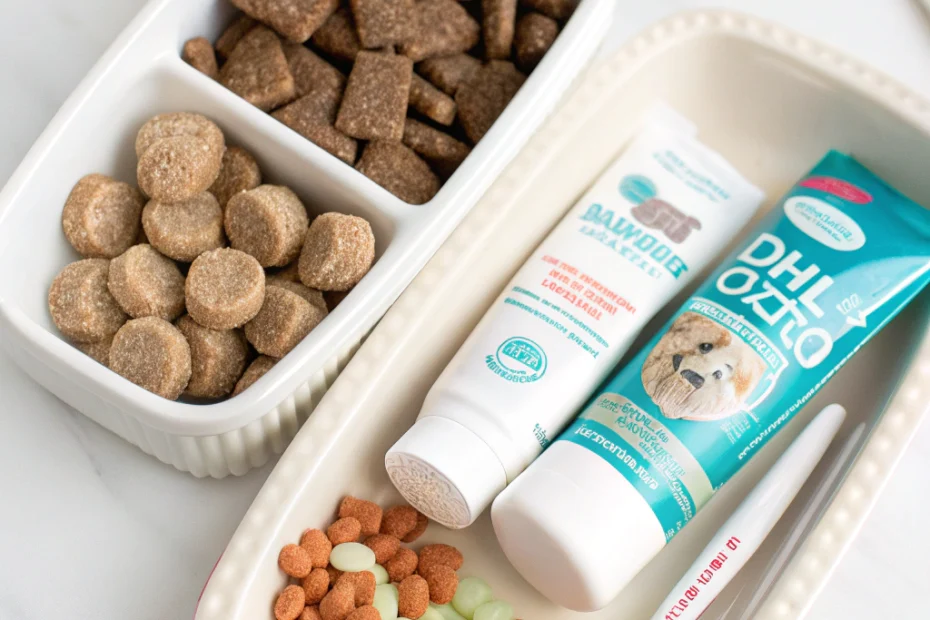At a Glance
- Gingivitis = gum inflammation caused mostly by plaque and bacteria.
- Best relief comes from daily hygiene, diet tailored for dental health, and regular veterinary care.
- Use cat-specific products only; introduce changes slowly and monitor your cat’s response.
How to Choose
- Cat-only products: Toothpastes, gels, rinses, and wipes labeled for feline use.
- Dental diets/chews: Therapeutic diets or VOHC-accepted options that help reduce plaque.
- Supplements: Only vet-recommended options (e.g., specific enzymes or seaweed-based powders) as adjuncts—never a replacement for brushing and professional care.
Safety & Setup
- Avoid human toothpastes (may contain xylitol/fluoride levels unsafe for cats).
- Start gradually: a few seconds of mouth handling, then build up to short brushing sessions.
- Create a calm, well-lit “brushing station”; reward with a favorite treat or brief play afterward.
- If you see drooling, pawing at the mouth, bleeding, or behavior changes after any product, stop and contact your veterinarian.
Core Pillars
- Dental hygiene: Regular brushing (ideally daily or at least 3–4×/week) to remove plaque before it hardens.
- Nutritional support: Balanced diet; dental formulas can help mechanically or chemically reduce plaque.
- Veterinary care: Professional cleanings under anesthesia as advised; exams to catch problems early.
Placement & Environment Tips
- Keep the brushing kit (finger brush, feline toothpaste, gauze) in one basket near a comfortable grooming spot.
- Wipe food and water bowls daily; wash thoroughly several times per week.
- Provide a stable, non-slip surface (yoga mat or towel) where your cat feels secure.
Step-by-Step: Brushing Routine
- Desensitize: Gently lift the lip and touch the gums with a finger for a few seconds; reward.
- Add flavor: Let your cat taste a pea-sized dab of feline toothpaste from your finger.
- Wipe first: Use gauze or a finger cot to rub the outer tooth surfaces in small circles.
- Brush: Switch to a soft cat brush or finger brush; angle bristles toward the gumline and use gentle circles, focusing on the upper back teeth where plaque accumulates.
- Keep it short: 30–60 seconds is fine at first; consistency matters more than duration.
What Actually Helps “Neutralize” Gingivitis
- Mechanical plaque removal: Brushing and professional cleanings are the most effective ways to reduce gum inflammation.
- Chemical control: Vet-approved gels/rinses and specific dental diets can reduce bacterial load and plaque adherence.
- Inflammation control: If gums are painful or very inflamed, your veterinarian may prescribe short-term medications and schedule a professional cleaning.
Home Tools (Vet-Approved)
- Finger brush/soft cat brush for gentle daily use.
- Feline toothpaste (enzymatic or chlorhexidine-based, as recommended by your vet).
- Dental wipes/gauze if your cat will not yet tolerate a brush.
- Dental diets/chews with proven plaque-reduction claims (ask your vet which are appropriate).
When to See the Vet
- Bad breath, drooling, difficulty eating, pawing at the mouth, or red/bleeding gums.
- Loose or broken teeth, facial swelling, or weight loss.
- Any time brushing is painful or your cat resists despite gentle training.
FAQs
Can I fix gingivitis without a professional cleaning?
Mild cases may improve with consistent home care, but most cats need at least one professional dental cleaning to fully reset gum health.
How often should I brush?
Daily is ideal; aim for a minimum of 3–4 times per week. Short, positive sessions beat long, stressful ones.
Do dental treats or water additives replace brushing?
No. They can help, but brushing and professional care are the foundation.
What if my cat won’t tolerate brushing?
Try wipes or gels first, build tolerance slowly, and discuss alternatives with your veterinarian (rinses, diets, scheduling a cleaning).
Bottom Line
The most reliable way to “neutralize” feline gingivitis is a combination of professional cleaning, consistent at-home plaque control (brushing), and a nutrition plan designed for dental health. Partner with your veterinarian to tailor the plan to your cat.
Medical disclaimer: This article is educational and not a substitute for veterinary care. Always consult your veterinarian for diagnosis and treatment tailored to your cat.
